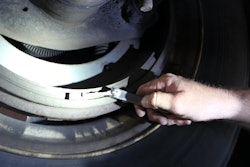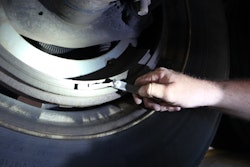By Denise Rondini
Alignments are high-volume, high-profit service work for shops willing to make the investment.
 It’s estimated that about 70 percent of trucks on the road are misaligned. With an average three-axle alignment job costing $275, there’s a lot of revenue available for a service shop with the right equipment and a technician trained to use it.
It’s estimated that about 70 percent of trucks on the road are misaligned. With an average three-axle alignment job costing $275, there’s a lot of revenue available for a service shop with the right equipment and a technician trained to use it.
Even better, not only is there plenty of need out there, but according to alignment experts, it is very profitable work.
Greg Brock, heavy-duty instructor for Hunter Engineering, says the billable hours compared to actual hours worked is in favor of the service provider. For instance, he says, three hours of labor is typically charged for an alignment that takes two to three hours to complete.
Dutch Johnson, training manager for Josam Products, Inc., says, “Alignment is almost all labor and menu priced. A three-axle alignment for $275 takes about an hour, the parts cost is almost zero and the tech cost is one hour. The cost of sale is very low compared to most other service sales.”
But the lure of high-volume, high-profit work isn’t enough for some service providers who balk at the perceived costs, difficulty of the work and the amount of shop space that needs to be devoted to it.
“Dealers [and other service providers] may not understand the profitability of alignments and some of them may be concerned about dedicating one whole area of the shop to alignments,” Brock says. “The biggest thing is they don’t understand how much of a profit center it can be. If they were to examine the amount of alignment work they outsource in a year, it might equal three times what it would cost them to own their own equipment.”
Understanding the cost-benefit ratio can help service providers make an informed decision about whether purchasing alignment equipment makes sense for their business.
Johnson gave the following example: If a service provider charges $200 per alignment, and most alignment technicians are comfortable performing four per day, a shop generates $800. The cost of the technician may be as high as $200 a day. A $25,000 alignment machine on a five-year lease costs about $600 per month, making the per-workday cost $30. In one day, the machine generates enough revenue to cover the lease payment for that month, and for the remaining 21 working days of the month, the profit total is $12,600.
Of course this number could be higher or lower depending on the cost of the alignment equipment and the number of alignments completed in a day. Some alignment equipment can run as high as $70,000 to $90,000 and technician time varies by region.
“It’s possible that a really good alignment technician could perform five alignments per day, and the payback is $17,000 a month. If it is used on weekends, you can add another $4,000 more per month for a total profit of $21,000,” Johnson explains. “The other extreme is the possibility of only two alignments per day, no additional parts sold and the operator spends his spare time cleaning the bay. The machine and operator costs remain fixed at $230 per day, while income has fallen to $400 per day. The monthly profit would be $4,000.”
Brock estimates that seven of 10 trucks that come to a shop have the potential to generate two-and-a-half to three hours of additional alignment-related labor on top of what they originally came in for.
Offering alignment services also provides the opportunity for additional parts sales. According to Mike McCoy, national accounts manager, BeeLine Co., 60 percent of trucks that need to be aligned have worn parts that have to be replaced before the alignment can be complete (see “Proper Vehicle Alignment Procedures” on page 27 for a step-by-step review of alignment procedures).
“Alignments are a great way to generate even more labor and parts,” Brock says. “You will be supplying labor dollar potential to the shop, to the technician and to the parts department so all three facets of the shop can be rewarded.”
Another reason service providers shy away from alignments is their perception of the amount of space that’s needed for the alignment equipment. However, all that is required to perform a basic alignment (where you set front toe and rear track) is a level floor.
“If you want to do full alignments where you are correcting for camber and twisting for caster you need a platform-style machine and you will have to dedicate a 50-foot bay to that type of system,” McCoy says.
“The best scenario is an inspection/lube pit with rolling bridge tables,” says Johnson. “It is critical that the operator not be on his knees or climbing around obstacles [when doing the inspection].”
Once you’ve purchased and installed the alignment equipment, you need to assign a technician to operate it. “You don’t have to hire someone with 20 years experience,” McCoy says. “You may be better off hiring someone with good technical knowledge and sending them to an alignment class.”
All alignment equipment manufacturers offer classes on alignment techniques. “Within a five-day course, the technician who has knowledge of suspension parts and knows how to turn a wrench is going to become pretty proficient,” he adds.
Initially the technician may not be able to complete an alignment in two hours. You may need to allow him three to four hours to complete one the first week, but after that he should be able to complete alignments in two hours.
To get the most out of your investment in alignment equipment, you need to aggressively pursue the business. Brock says that if a customer’s truck is in your shop waiting for parts to complete a repair, you may want to put the vehicle on the alignment equipment to measure it. The equipment will generate a print out showing the customer the measurements for all three axles. This gives the service manager the opening to upsell an alignment while the truck is already in the shop.
You need to teach your service writer to sell the service. One simple thing they can do is look at the tires to see if there are wear problems. Abnormal tire wear is a clue that a vehicle is out of alignment. You should consider using displays in the shop to show customers they will see a two percent increase in fuel economy and that tires will last 30 percent longer with a properly aligned vehicle.
Service providers may be concerned about investing in alignment equipment while business is down. But, according to McCoy, this is a good time to make the investment. “When things are tough is when you need it” to bolster profits. “Now is the time to spend to get new business in the shop.”









